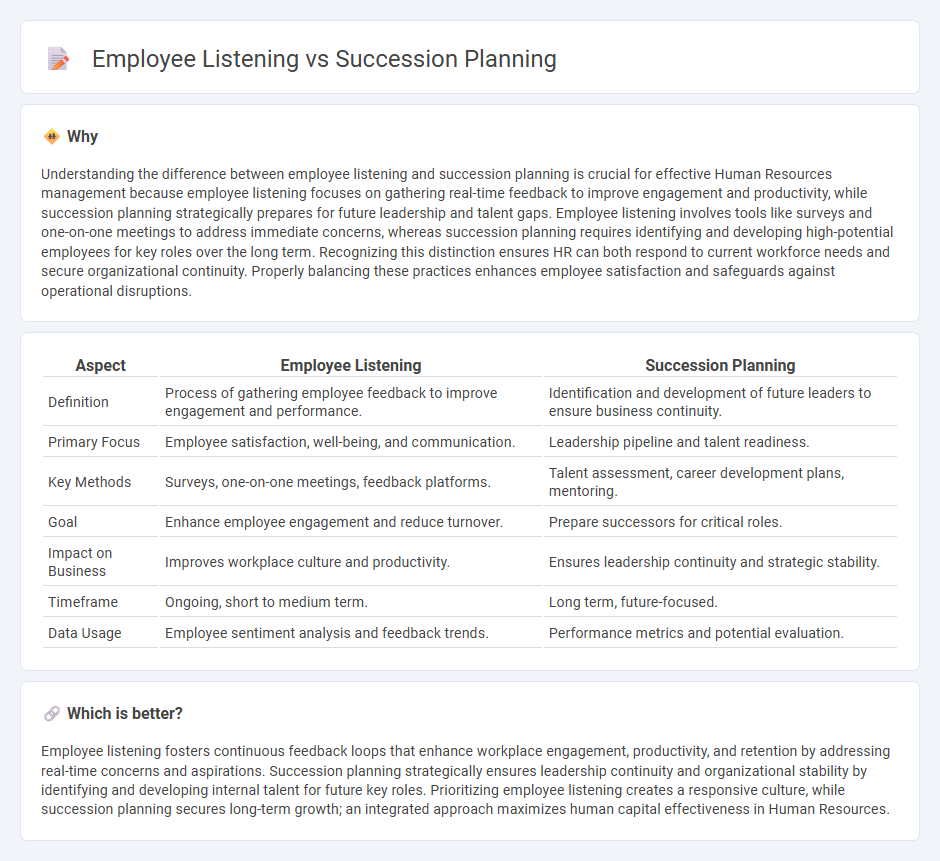
Employee listening enhances organizational insight by capturing real-time feedback, boosting engagement and retention through active communication channels. Succession planning identifies and develops future leaders to ensure business continuity and strategic talent management. Explore deeper strategies to integrate both approaches for a resilient workforce.
Why it is important
Understanding the difference between employee listening and succession planning is crucial for effective Human Resources management because employee listening focuses on gathering real-time feedback to improve engagement and productivity, while succession planning strategically prepares for future leadership and talent gaps. Employee listening involves tools like surveys and one-on-one meetings to address immediate concerns, whereas succession planning requires identifying and developing high-potential employees for key roles over the long term. Recognizing this distinction ensures HR can both respond to current workforce needs and secure organizational continuity. Properly balancing these practices enhances employee satisfaction and safeguards against operational disruptions.
Comparison Table
| Aspect | Employee Listening | Succession Planning |
|---|---|---|
| Definition | Process of gathering employee feedback to improve engagement and performance. | Identification and development of future leaders to ensure business continuity. |
| Primary Focus | Employee satisfaction, well-being, and communication. | Leadership pipeline and talent readiness. |
| Key Methods | Surveys, one-on-one meetings, feedback platforms. | Talent assessment, career development plans, mentoring. |
| Goal | Enhance employee engagement and reduce turnover. | Prepare successors for critical roles. |
| Impact on Business | Improves workplace culture and productivity. | Ensures leadership continuity and strategic stability. |
| Timeframe | Ongoing, short to medium term. | Long term, future-focused. |
| Data Usage | Employee sentiment analysis and feedback trends. | Performance metrics and potential evaluation. |
Which is better?
Employee listening fosters continuous feedback loops that enhance workplace engagement, productivity, and retention by addressing real-time concerns and aspirations. Succession planning strategically ensures leadership continuity and organizational stability by identifying and developing internal talent for future key roles. Prioritizing employee listening creates a responsive culture, while succession planning secures long-term growth; an integrated approach maximizes human capital effectiveness in Human Resources.
Connection
Employee listening gathers crucial insights into staff skills, aspirations, and concerns, enabling HR to identify potential leaders and address workforce gaps effectively. Succession planning leverages this data to develop tailored development programs and ensure a seamless transition in key roles. Integrating both practices enhances talent retention and builds a resilient organizational leadership pipeline.
Key Terms
**Succession Planning:**
Succession planning strategically identifies and develops future leaders within an organization to ensure business continuity and minimize leadership gaps. It involves talent assessment, skill development, and creating growth pathways aligned with organizational goals. Explore how effective succession planning can secure your company's long-term success.
Talent Pipeline
Succession planning strategically identifies and develops future leaders to ensure a robust talent pipeline, safeguarding organizational resilience. Employee listening captures real-time insights and engagement levels, informing talent decisions and enhancing workforce alignment. Explore how integrating both approaches optimizes talent pipeline management.
Leadership Development
Succession planning ensures leadership continuity by identifying and preparing high-potential employees for future key roles, while employee listening gathers real-time feedback to address leadership challenges and foster growth. Integrating these strategies enhances leadership development by aligning talent pipelines with organizational culture and employee needs. Explore how combining succession planning with employee listening can transform leadership effectiveness.
Source and External Links
Succession Planning: All You Need To Know [2025 Edition] - AIHR - Succession planning is the process of selecting and developing key talent to ensure the continuity of critical roles, involving creating a succession chart, identifying key positions, and assessing current talent through evaluations and feedback.
Succession Planning: 7-Step Guide & Template - Paylocity - Succession planning is a long-term strategy to identify and prepare employees to replace key roles, ensuring business continuity and improving retention by developing skills for future leadership.
Succession planning - Wikipedia - Succession planning is a strategy for replacement planning to identify and develop internal candidates to fill key roles in organizations, often involving leadership skill development and sometimes advisors to assist transitions in family businesses.
 dowidth.com
dowidth.com